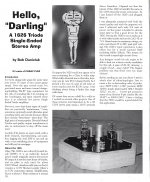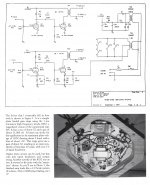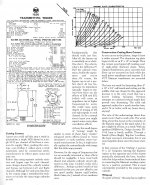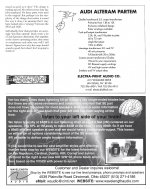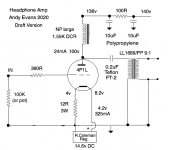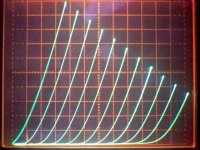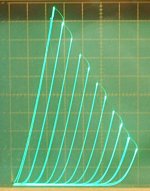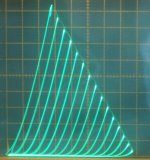After getting my hands wet on couple of tube amps. I am planning on make a tube SE OTL headphone amp for a 600ohm headphone. What would be a good tube with a simple design for this?
I have a number of Russian and Chinese premium tubes on hand (6n1p, 6n23p, 6n6p, 6sn7, el84, el34)
Working with either 230V or 60V (battery step up). I really don't need any additional gain. What would be a good tube for this?
I have a number of Russian and Chinese premium tubes on hand (6n1p, 6n23p, 6n6p, 6sn7, el84, el34)
Working with either 230V or 60V (battery step up). I really don't need any additional gain. What would be a good tube for this?
Im just try finding best low power tube, so i read a larger number of opinion of tubes. 4P1L - not just "worst", in rating one amator take 2nd place, after 6c4c. This tube have got awesome sound, sure. But i must find best of the best.
Just FYI, the 2a3 and 45 are darn near interchangeable. If you use a 5K load that can handle the current of the 2a3, and a filament transformer that can handle the filament current of the 2a3, you can pretty much swap the two tubes back and forth.
You can take this one step further. By using a handful of resistors you can take the same amp and run a 71a as well. Just drop the B+ voltage, filament voltage, and change the bias resistor out and you can drop in a 71a.
So if you are clever about things, you can run 3 of these tubes on the same platform.
I finding this site.
Home | VT52.com
His creator has been a evolution, from 71a, WE437A, 45, 46, 300b, 2a3 to 1626 at bi amping.
Also intetresting about 31 triode in out. This triode DHT - is a 375 mw power only. Most little tube for UX4 socket.
Home | VT52.com
His creator has been a evolution, from 71a, WE437A, 45, 46, 300b, 2a3 to 1626 at bi amping.
Also intetresting about 31 triode in out. This triode DHT - is a 375 mw power only. Most little tube for UX4 socket.
I love my Darling amp that uses 1626 tubes. The beauty of this amp is that with a simple socket adaptor it becomes a 12B4A SET and while using the 8 pins socket I also have the option of triode strapped 12V6 (a resistor must be added).
There you have it ; 3 amps into 1, simply by changing tubes, no bias adjustment needed. You choose: 1626 or 12B4A or 12V6
BR
Eric
Here is the original article lifted from the pages of Sound Practices Issue 15.
Attachments
I know that Russian DIYers that call themselves "Audiophiles" also prefer copper wires from cables from German WW-II submarines.
This made my day!
It is exactly what I said, a good tube for effect boxes, unlike 6P15P or 4P1L. I know that Russian DIYers that call themselves "Audiophiles" also prefer copper wires from cables from German WW-II submarines.
Sheesh, talk about unobtainium. I suppose they won't accept anything other than an original Marinair LO1166 for a line-level transformer as well.
The market for "NOS" wire is something I will never understand. Do they just want to find the moldiest, crustiest wire available? And on the copper wire from German submarines, do they just really like the smell of diesel? Because that's what it probably smells like.
Read in a nasally voice:
"In order to ensure I get only the best sound quality out of my sound system, the insulation on my speaker wires is comprised of no less than 80% deteriorating, friable asbestos."
I've used a lot of DHTs for 12 years. For low power, I'd probably say 10Y. Really low power, 01A. Both thoriated filaments. 26 is nice and a little warmer. 46 is more solid. 6C4C was better as an output tube. 4P1L has much to recommend it - low plate resistance, gain of x 11, easy to drive, can be used in filament bias without a cathode bypass. Sound-wise I find it has good treble and bass but is leaner in the midrange. For good mids I'd use a 10Y.
For headphones a low plate resistance makes the job easier, which makes 26 and 01A less usable.
I've never used a 45. I like the 300b a lot, who doesn't. It's a possibility to try. I'd certainly go DHT.
For headphones a low plate resistance makes the job easier, which makes 26 and 01A less usable.
I've never used a 45. I like the 300b a lot, who doesn't. It's a possibility to try. I'd certainly go DHT.
Last edited:
Tubes don't make any sound!
It's the complete circuitry that matters.
Well yes, that's always the case. But tubes do have a distinctive sound. If you optimise the circuit you're never going to get a 6L6 to sound like a 300b, or a 12AU7 to sound like a 01A.
Tubes don't make any sound! It's the complete circuitry that matters.
This is most definitely true, but some tubes like the 300B have such a large "sweet spot" that it's hard to make a "bad" amp unless you really don't have a clue, in which case you need some "magic" parts to clean up your mess.
DIYers that call themselves "Audiophiles" also prefer copper wires from cables from German WW-II submarines.
I might have a box full of Teflon / Silver stranded wire from a Korean war era US fighter jet. It's too heavy for signal wiring but makes for some good heater wire since it is all twisted pair. I used most of it to wire up a car.
I helped a friend strip out all the avionics and other electronics from the plane and in the process acquired a box full of wire that probably cost the US taxpayers $50 per foot.
I'm surprised nobody's raised the question of what 'best sounding' means.
If you're making an amp with OPT, doesn't the transformer color the sound quite a bit? More than the output tube?
What about spectrum of THD? The OPT has a lot to do with that too.
What about the power supply? Would a regulated B+ and heater supply make a huge difference?
I know I'm not even remotely as prolific a builder as most on this forum, especially the heavy dudes (you know who you are), but since a headphone amp really only needs to deliver about a quarter of a watt into 32 ohms (at the very most), there are umpteen million ways to make a perfectly good headphone amp using a tube or two, an OPT, and a power supply.
If you choose a high gm RF pentode like 12GN7A, wire it triode, and use a good, low-insertion loss OPT, add a good power supply and you have a perfectly good headphone amp with lots of headroom. I used an Edcor 8k:50 OPT for mine, but I'm sure there are better choices (for more $$$). The gain is just right too. To get loud I need to turn the volume up past 12 o'clock, into either a Sennheiser HD650, Audio Technica ATH-M30, or Fostex T50RP. Background music listening is done with the volume control around 10 o'clock, except with the Fostex cans because they're less sensitive. The amp is a bit dark sounding, but I like that for headphone listening.
So.... What does "best sound" mean to you? Euphonic? Romantic? Super smooth or 'rounded off'? Super clean and 'fast'? Compressed dynamics so you can hear every little detail? Wide dynamics so drum hits go !!POP!!?
--
If you're making an amp with OPT, doesn't the transformer color the sound quite a bit? More than the output tube?
What about spectrum of THD? The OPT has a lot to do with that too.
What about the power supply? Would a regulated B+ and heater supply make a huge difference?
I know I'm not even remotely as prolific a builder as most on this forum, especially the heavy dudes (you know who you are), but since a headphone amp really only needs to deliver about a quarter of a watt into 32 ohms (at the very most), there are umpteen million ways to make a perfectly good headphone amp using a tube or two, an OPT, and a power supply.
If you choose a high gm RF pentode like 12GN7A, wire it triode, and use a good, low-insertion loss OPT, add a good power supply and you have a perfectly good headphone amp with lots of headroom. I used an Edcor 8k:50 OPT for mine, but I'm sure there are better choices (for more $$$). The gain is just right too. To get loud I need to turn the volume up past 12 o'clock, into either a Sennheiser HD650, Audio Technica ATH-M30, or Fostex T50RP. Background music listening is done with the volume control around 10 o'clock, except with the Fostex cans because they're less sensitive. The amp is a bit dark sounding, but I like that for headphone listening.
So.... What does "best sound" mean to you? Euphonic? Romantic? Super smooth or 'rounded off'? Super clean and 'fast'? Compressed dynamics so you can hear every little detail? Wide dynamics so drum hits go !!POP!!?
--
Last edited:
Overall best sound. Just natural.I'm surprised nobody's raised the question of what 'best sounding' means.
If you're making an amp with OPT, doesn't the transformer color the sound quite a bit? More than the output tube?
What about spectrum of THD? The OPT has a lot to do with that too.
What about the power supply? Would a regulated B+ and heater supply make a huge difference?
I know I'm not even remotely as prolific a builder as most on this forum, especially the heavy dudes (you know who you are), but since a headphone amp really only needs to deliver about a quarter of a watt into 32 ohms (at the very most), there are umpteen million ways to make a perfectly good headphone amp using a tube or two, an OPT, and a power supply.
If you choose a high gm RF pentode like 12GN7A, wire it triode, and use a good, low-insertion loss OPT, add a good power supply and you have a perfectly good headphone amp with lots of headroom. I used an Edcor 8k:50 OPT for mine, but I'm sure there are better choices (for more $$$). The gain is just right too. To get loud I need to turn the volume up past 12 o'clock, into either a Sennheiser HD650, Audio Technica ATH-M30, or Fostex T50RP. Background music listening is done with the volume control around 10 o'clock, except with the Fostex cans because they're less sensitive. The amp is a bit dark sounding, but I like that for headphone listening.
So.... What does "best sound" mean to you? Euphonic? Romantic? Super smooth or 'rounded off'? Super clean and 'fast'? Compressed dynamics so you can hear every little detail? Wide dynamics so drum hits go !!POP!!?
--
There is a general concept of better sound. When subjective tastes and preferences recede, and everyone agrees that it is better. I had this when I bought headphones, 20 years ago, Philips 915, and everyone I didn’t give, agreed that the sound was natural.
If there are different types of vision on the sound of devices, then these devices are of the same quality level.
Gapped SE OTs have a 2nd harmonic variation of permeability versus signal due to the DC offset. (versus 3rd H for P-P OT's) This causes the magnetizing current to have a similar 2nd H variation. Leading to 2nd H loading on the tube.
So the question arises whether the tube should provide just the right amount of 2nd H from it's plate curves to cancel that. So it really boils down to the particular OT choice as to what tube will cancel the dominant 2nd H distortion. (assuming that's wanted)
For perfect OTs (haha, good luck finding..) there are perfect tubes:
( for real OTs you'll have to do some matching up with tube curves) There is no general "best" tube.
So the question arises whether the tube should provide just the right amount of 2nd H from it's plate curves to cancel that. So it really boils down to the particular OT choice as to what tube will cancel the dominant 2nd H distortion. (assuming that's wanted)
For perfect OTs (haha, good luck finding..) there are perfect tubes:
( for real OTs you'll have to do some matching up with tube curves) There is no general "best" tube.
Attachments
. . . . . . I was stunned by the sound quality.
Coming from somebody who has done as much as you have, that's quite a statement. May I ask where you were running the 45 and what plate load you put on it? I have a couple of old 45s that I tried years ago but never got a sound worth keeping. . . . . . .
I ran the 45's at about 25 mA to 30 mA and the B+ is 320 volts which is slightly over spec. This does not seem to be an issue since the amp still uses the same pair of used 45's that I got on Ebay over 17 years ago when you could find them for under $10 each.
The amp runs Electra Print 5K to 8 ohm OPT's. I simply wired my 32 ohm phones across the output which puts a 20K load on the tubes. This was all done on my 17 year old TSE amp.
In a more recent experiment I had a TSE-II board on the bench for some testing. It runs 10 year old Chinese 2A3's on 370 volts (way over spec). I have used a bias current from 50 mA to 70 mA. They are running this much voltage because I already had a power transformer from a P-P EL84 amp, so I tried it.....that was over a year ago. It also lets me run 300B's, so I kept it. It will stay in the final build.
The OPT's are 3K Transcendars designed for 300B's. Again I wired the 32 ohm phones across the output. The TSE-II is a very quiet amp, so hum, hiss and other noise is not an issue, but the amp can put almost a watt into a 32 ohm load, so things like loose cables and even a microphonic tube could blow your phones, or crack your head!
In this case I played with different resistors in parallel with the headphones, and different bias current settings with lots of different music. As usual with too many variables, it's too hard to find a "one size fits all" combination.
I pulled that setup off the bench to test some other stuff, but there is currently a 22 ohm resistor wired across the output.
I would imagine that the results could be quite different with different headphones and music.
I have never been a big headphone fan because my head sweats too much. Both my current pairs of cans are light weight Sennheisers. I have a big pair of Philips cans for my mixing desk, but I can only wear them for short periods of time. Even so, the foam donuts have are already falling apart.
The amp runs Electra Print 5K to 8 ohm OPT's. I simply wired my 32 ohm phones across the output which puts a 20K load on the tubes. This was all done on my 17 year old TSE amp.
In a more recent experiment I had a TSE-II board on the bench for some testing. It runs 10 year old Chinese 2A3's on 370 volts (way over spec). I have used a bias current from 50 mA to 70 mA. They are running this much voltage because I already had a power transformer from a P-P EL84 amp, so I tried it.....that was over a year ago. It also lets me run 300B's, so I kept it. It will stay in the final build.
The OPT's are 3K Transcendars designed for 300B's. Again I wired the 32 ohm phones across the output. The TSE-II is a very quiet amp, so hum, hiss and other noise is not an issue, but the amp can put almost a watt into a 32 ohm load, so things like loose cables and even a microphonic tube could blow your phones, or crack your head!
In this case I played with different resistors in parallel with the headphones, and different bias current settings with lots of different music. As usual with too many variables, it's too hard to find a "one size fits all" combination.
I pulled that setup off the bench to test some other stuff, but there is currently a 22 ohm resistor wired across the output.
I would imagine that the results could be quite different with different headphones and music.
I have never been a big headphone fan because my head sweats too much. Both my current pairs of cans are light weight Sennheisers. I have a big pair of Philips cans for my mixing desk, but I can only wear them for short periods of time. Even so, the foam donuts have are already falling apart.
- Status
- This old topic is closed. If you want to reopen this topic, contact a moderator using the "Report Post" button.
- Home
- Amplifiers
- Tubes / Valves
- Best sounding tube for low power?

